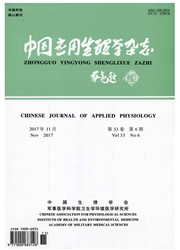

 中文摘要:
中文摘要:
目的:乙酰胆碱(ACh)不仅是神经递质,也是一种有效的血管舒张物质参与许多血管床的调节活动。本实验观察ACh引起耳蜗螺旋动脉平滑肌细胞超极化的离子机制以及NO在超极化反应中的可能作用。方法:在豚鼠离体耳蜗螺旋动脉标本上,运用细胞内微电极技术记录外源性的ACh引起的反应。结果:在保持灌流液中含有5mmol/L K^+以及最小纵向张力的情况下,ACh(0.1—10μmol/L)引起低静息膜电位细胞明显的超极化反应,而引起高静息膜电位细胞明显的去极化反应。ACh引起的平滑肌细胞超极化反应是浓度依赖性的(ACh的浓度是1μmol/L和10/μmol/L时,分别引起超极化的幅度是22和30mV,n=7)。ACh引起的超极化反应能被阿托品(atropine,0.1~1μmol/L,n=6)或DAMP(50~100nmol/L,n=6,一种选择性的地受体的拮抗剂)所阻断,同时也可被BAPTA—AM(10μmol/L,n=7,一种可通过细胞膜的Ca^2+螯合剂)或eharybdotoxin+apamin(50-100nmol/L,n=4,两种Ca^2+激活K^+通道的阻断剂)所阻断,但是Nω-nitro-L-arginine methyl ester(L-NAME,300μmol/L,n=8,一种NO合成酶的完全抑制剂,n≥5)或glipizide(10μmol/L,ATP敏感性的K^+通道阻断剂,n=4)或indomethacin(10μmol/L,环氧合酶的抑制剂,n=4)不能阻断ACh引起的超极化反应。结论:ACh通过激活内皮细胞的M3受体,开放钙依赖的钾通道.进而引起耳蜗螺旋动脉平滑肌细胞产生超极化反应,并且这一超极化反应与内皮细胞NO的产生和释放无关。
 英文摘要:
英文摘要:
Aim: Acetylcholine(ACh) is a and a potent vasodilator in many vascular beds. ACh hyperpolarizes the smooth muscle cells(SMCs) of arteries including the cochlear spiral modiolar artery(SMA) via an endothelium-dependent mechanism, but the biochemical and biophysical basis of the hyperpolarization and vasodilation remain unclear and controversial. Methods: Using intracellular recording techniques and an in vitro preparation of the SMA, the ionic mechanism of the hyperpolarization and a possible role of nitric oxide(NO) were investigated. Results: With 5 mmol/L K^+ in the bathing solution and a minimum longitudinal tension, ACh(0.1 - 10 μmol/L) induced a robust hyperpo- larization in low RP cells but caused a depolarization in the high RP cells. The ACh hyperpolarization was fast in onset and offset and the amplitude was concentration-dependent(22 and 30 mV by 1 μmol/L and 10 μmol/L ACh, respectively, n = 7 ). ACh also hyperpola-rized the cells that initially had a high resting potential(RP) but were pre-depolarized by Ba^2+ (50 - 100 μmol/L). The onset time courses of the hyper- polarization were often slower in these cases than those without the presence of Ba^2 + . The ACh-induced hyperpolarization was blocked by atropine (0.1 -1 μmol/L, n = 6) or DAMP(50- 100 nmol/L, n = 6, a selective M3 antagonist) and also by BAPTA-AM(10 μmol/L, n = 7, a membrane-permeable Ca^2+ -chelator), or charybdotoxin pins apamin(50 - 100 nmol/L, n = 4, Ca^2+ -activated K^+ -channel blockers), but not by Nω-nitro-L-arginine methyl ester(L-NAME, 300 μmol/L, n = 8, an inhibitor of NO-synthase), glipizide( 10 μmol/L, n = 4, ATP- sensitive K^+ -channel blocker) and indomethacin( 10 μmol/L, n = 4, cyclo-oxygenase inhibitor). Conclusion: It is concluded that ACh-induced hyperpolarization in the arterial SMCs is primarily due to an activation of calcium-activated potassium channels via M3 receptors of endothelial cell and is independent of NO-release in
 同期刊论文项目
同期刊论文项目
 同项目期刊论文
同项目期刊论文
 期刊信息
期刊信息
